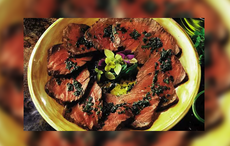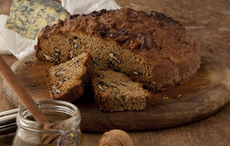The leaves are changing, there's a nip in the air, the nights are getting longer... with all that said it's also a time to get back to baking and treat yourself!
This delightful dessert offers a seasonal spin on the beloved summer pudding, infusing it with the tangy flavors of Bramley apples and plums. The rich, fruity base is balanced by a hint of red wine and blackcurrant liqueur, while the soft bread encases a medley of autumnal fruits. Serve it with a vibrant berry sauce and a dollop of cream or crème fraîche for the perfect finishing touch.
This is similar to a luscious summer pudding, but the gorgeous tartness of the Bramley apples adds another dimension to the usual very-berry pudding. The plums also work really well, adding great texture and color.
Read more
IRISH AUTUMN PUDDING
Ingredients:
- 14 oz Bramley apples.
- 14 oz plums.
- 9 oz fresh or frozen blackberries.
- 4 ½ oz golden brown sugar.
- 4 fl oz dry red wine.
- 4 tablespoons crème de cassis (blackcurrant liqueur).
- About 10-12 slices of white bread, crusts removed.
- Fresh mint sprig, to decorate (optional).
- A sprig of redcurrants, to decorate (optional).
- Cream or crème fraiche, to serve.
For the berry sauce
- 1lb fresh or frozen blackberries or mixed berries.
- Juice of 1 lemon, or to taste.
- 5oz sugar, or to taste.
Method:
Peel, core and roughly chop the apples. Aim to make the pieces about the same-size so that they cook evenly.
Halve and stone the plums and roughly chop them. Place the apples and plums in a medium-sized saucepan along with the blackberries, sugar and wine and place over a medium heat. Bring to the boil then simmer gently for about 15 minutes, or until the apple pieces are soft and rather mushy.
Take off the heat and add the crème de cassis. Leave to cool.
Line the inside and base of a 1-litre (2.1-pint) bowl or mould with the slices of bread. Overlap the slices slightly on the sides to ensure that the filling does not leak through. Any leftover bits of bread can be used to cover the filling (this will be the bottom of the pudding when it is turned out).
Place the cooked, cooled fruit carefully in the lined mould and press it down quite firmly. Fill it nearly to the top, and then cover it completely with the remaining bread. Weigh this down with a can on a plate and place in the fridge overnight.
To make the berry sauce, simply purée the berries with the lemon juice and sugar in a food processor. Pass through a fine sieve and taste for flavour. Adjust with more sugar or lemon juice as necessary.
To serve, carefully turn the pudding out onto a serving plate.
Brush any uncolored bits of bread with a little sauce and decorate with a mint sprig and a sprig of redcurrants on the top, if you wish. Cut the pudding into wedges and serve with a dollop of fresh cream or crème fraiche, and some of the berry sauce on the side.
* Originally published in September 2009. Updated in September 2025.




Comments